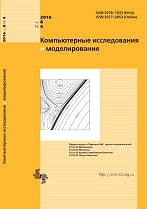|
MODELS IN PHYSICS AND TECHNOLOGY
Cities road networks
I. A. Yevin, V. V. Komarov, M. S. Popova, A. Yu. Samsonova
Moscow Institute of Physics and Technology (State University),
9 Institutskiy lane, Moscow region, Dolgoprudny, 141700, Russia
Abstract:
Road network infrastructure is the basis of any urban area. This article compares the structural characteristics (meshedness coefficient, clustering coefficient) road networks of Moscow center (Old Moscow), formed as a result of self-organization and roads near Leninsky Prospekt (postwar Moscow), which was result of cetralized planning. Data for the construction of road networks in the form of graphs taken from the Internet resource OpenStreetMap, allowing to accurately identify the coordinates of the intersections. According to the characteristics of the calculated Moscow road networks areas the cities with road network which have a similar structure to the two Moscow areas was found in foreign publications. Using the dual representation of road networks of centers of Moscow and St. Petersburg, studied the information and cognitive features of navigation in these tourist areas of the two capitals. In the construction of the dual graph of the studied areas were not taken into account the different types of roads (unidirectional or bi-directional traffic, etc), that is built dual graphs are undirected. Since the road network in the dual representation are described by a power law distribution of vertices on the number of edges (scale-free networks), exponents of these distributions were calculated. It is shown that the information complexity of the dual graph of the center of Moscow exceeds the cognitive threshold 8.1 bits, and the same feature for the center of St. Petersburg below this threshold, because the center of St. Petersburg road network was created on the basis of planning and therefore more easy to navigate. In conclusion, using the methods of statistical mechanics (the method of calculating the partition functions) for the road network of some Russian cities the Gibbs entropy were calculated. It was found that with the road network size increasing their entropy decreases. We discuss the problem of studying the evolution of urban infrastructure networks of different nature (public transport, supply , communication networks, etc.), which allow us to more deeply explore and understand the fundamental laws of urbanization.
Keywords:
meshedness coefficient, betweenness centrality, the dual representation of the network, navigation, the Gibbs entropy.
Received: 16.05.2016
Revised: 16.09.2016
Accepted: 10.10.2016
Citation:
I. A. Yevin, V. V. Komarov, M. S. Popova, A. Yu. Samsonova, “Cities road networks”, Computer Research and Modeling, 8:5 (2016), 775–786
Linking options:
https://www.mathnet.ru/eng/crm27 https://www.mathnet.ru/eng/crm/v8/i5/p775
|

| Statistics & downloads: |
| Abstract page: | 319 | | Full-text PDF : | 334 | | References: | 35 |
|




 Contact us:
Contact us: Terms of Use
Terms of Use
 Registration to the website
Registration to the website Logotypes
Logotypes









 Citation in format
Citation in format 